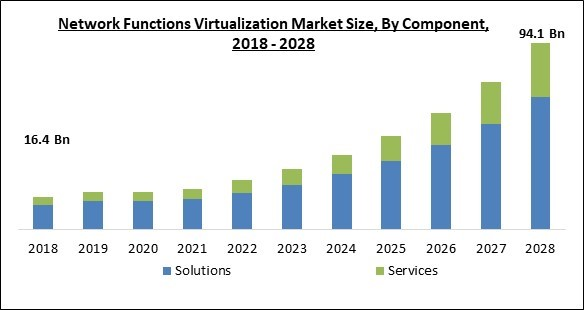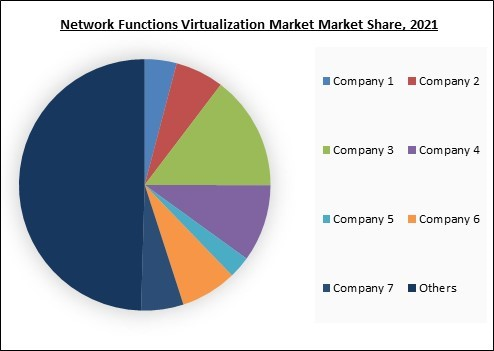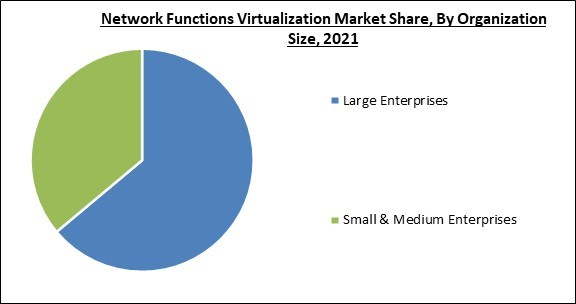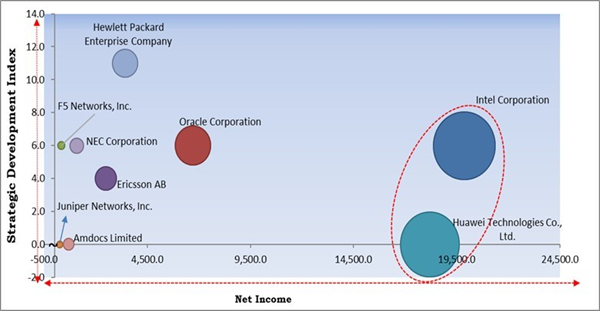The Global Network Functions Virtualization Market size is expected to reach $94.1 billion by 2028, rising at a market growth of 24.8% CAGR during the forecast period.
Network functions virtualization, or NFV, can be defined as a network architecture concept that leverages IT virtualization technologies in order to virtualize entire sections of network node functions into building blocks that can be connected to each other or chained together to produce and deliver communication services. NFV depends on conventional server virtualization strategies, like those employed in enterprise IT.
Instead of using specialized hardware appliances for every network function, a virtualized network function, or VNF, is deployed within one or even more virtual machines or containers that are each running different software and processes on top of high-volume commercial off-the-shelf (COTS) servers, switches, storage devices, and cloud computing infrastructure. This prevents vendor lock-in. For instance, to safeguard a network, a virtual session border controller can be used instead of actual network protection units, which are typically more expensive and complicated to buy and install.
Other NFV examples include virtualized firewalls, load balancers, WAN accelerators, and intrusion detection systems, to mention a few. By separating the network function software from the specialized hardware platform, a flexible network architecture is realized, allowing for rapid service rollouts, agile network administration, and a significant decrease in CAPEX and OPEX. With the help of NFV, communication services may be separated from specialized hardware like routers and firewalls.
Because of this division, network operations can offer new services on demand and without buying new hardware. With network functions virtualization, network components can be deployed in a matter of hours as opposed to months as with conventional networking. Additionally, rather than using expensive proprietary hardware, the virtualized services can function on less expensive generic servers. Network function virtualization essentially takes the role of the features offered by separate hardware networking components.
The leading players in the market are competing with diverse innovative offerings to remain competitive in the market. The below illustration shows the percentage of revenue shared by some of the leading companies in the market. The leading players of the market are adopting various strategies in order to cater demand coming from the different industries. The key developmental strategies in the market are Acquisitions, and Partnerships & Collaborations.
The major strategies followed by the market participants are Partnerships and Acquisition. Based on the Analysis presented in the Cardinal matrix; Intel Corporation and Huawei Technologies Co., Ltd. are the forerunners in the Network Functions Virtualization Market. Companies such as Hewlett Packard Enterprise Company, Oracle Corporation, Ericsson AB are some of the key innovators in Network Functions Virtualization Market.
The market research report covers the analysis of key stake holders of the market. Key companies profiled in the report include Intel Corporation, Oracle Corporation, Huawei Technologies Co., Ltd. (Huawei Investment & Holding Co., Ltd.), Ericsson AB, Hewlett Packard Enterprise Company, Juniper Networks, Inc., NEC Corporation, Amdocs Limited, F5 Networks, Inc, and Alcatel-Lucent Enterprise (China Huaxin Post and Telecom Technologies Co., Limited).
Network functions virtualization, or NFV, can be defined as a network architecture concept that leverages IT virtualization technologies in order to virtualize entire sections of network node functions into building blocks that can be connected to each other or chained together to produce and deliver communication services. NFV depends on conventional server virtualization strategies, like those employed in enterprise IT.
Instead of using specialized hardware appliances for every network function, a virtualized network function, or VNF, is deployed within one or even more virtual machines or containers that are each running different software and processes on top of high-volume commercial off-the-shelf (COTS) servers, switches, storage devices, and cloud computing infrastructure. This prevents vendor lock-in. For instance, to safeguard a network, a virtual session border controller can be used instead of actual network protection units, which are typically more expensive and complicated to buy and install.
Other NFV examples include virtualized firewalls, load balancers, WAN accelerators, and intrusion detection systems, to mention a few. By separating the network function software from the specialized hardware platform, a flexible network architecture is realized, allowing for rapid service rollouts, agile network administration, and a significant decrease in CAPEX and OPEX. With the help of NFV, communication services may be separated from specialized hardware like routers and firewalls.
Because of this division, network operations can offer new services on demand and without buying new hardware. With network functions virtualization, network components can be deployed in a matter of hours as opposed to months as with conventional networking. Additionally, rather than using expensive proprietary hardware, the virtualized services can function on less expensive generic servers. Network function virtualization essentially takes the role of the features offered by separate hardware networking components.
COVID-19 Impact Analysis
The IT and telecommunications sector, among others, was severely impacted by countermeasures including blockades, social isolation, and quarantine to combat the infection, due to which, the utilization of network functions virtualization software was reduced in the sector. For several months, various manufacturing facilities were shut down, which had a negative impact on the supply chain, the ability to import and export end devices, as well as the production, sales, and operations of the sector. The network functions virtualization market and revenues were impacted by supply chain disruptions and delays in the introduction of 5G standards. Due to this, the market was negatively impacted by the emergence of the pandemic. Hence, the market is estimated to recover from the impact of the COVID-19 pandemic in the coming years.The leading players in the market are competing with diverse innovative offerings to remain competitive in the market. The below illustration shows the percentage of revenue shared by some of the leading companies in the market. The leading players of the market are adopting various strategies in order to cater demand coming from the different industries. The key developmental strategies in the market are Acquisitions, and Partnerships & Collaborations.
Market Growth Factors
Helps Businesses In Saving Costs And Boosting Agility
Carriers must offer more bandwidth at a reduced price. However, high bandwidth requirements or on-demand services were not incorporated into traditional carrier networks. Additionally, it is costly, complicated, and ineffective to attempt to improve already-existing hardware-based networks. As a result, carrier income is now growing slower than networking costs. Additionally, this is not a long-term business strategy. By separating network software from hardware, network functions virtualization solutions are intended to assist carriers in moving away from proprietary network hardware, which considerably reduces costs and improves service agility.Rising Number Of Initiatives And Efforts By Market Players
NFV's benefits and concepts are straightforward, but putting it into practice becomes more difficult. This is due to the fact that NFV requires some level of engagement and collaboration between different network solution suppliers and network operators in order to fully benefit from it. Industry associations can help in such situations. Industry Specification Group, or ISG, for NFV, is being formed by the top network operators all over the world at a very rapid speed. Even while there is a lot of interest in the efforts of such associations to define the NFV framework, it is just one of many aspects in this rapidly expanding sector of industry development.Marketing Restraining Factor:
Security And Scalability Risks
What will happen to their job if their assets are unavailable is the biggest concern that many people have about virtualization. An organization is expected to find it difficult to compete in its business if it is unable to access its data for an extended length of time. Additionally, since availability is managed by outside providers, virtualization does not provide users control over their ability to maintain connectivity. Although virtualization makes it possible to expand a business or prospect quickly, users might not be able to do so as quickly as they consider. A virtualized network experiences lag as a result of growth since numerous entities share the same resources.Component Outlook
On the Basis of Component, the Network Functions Virtualization Market is bifurcated into Solutions and Services. In 2021, the solution segment acquired the largest revenue share of the network function virtualization market. The growth of the segment is ascribed to the rising adoption of automation and virtualization technologies. The need for mobility services is predicted to increase, and businesses' significance in lowering operating costs through NFV is expected to expand. The solution consists of orchestration and automation as well as additional elements like virtual infrastructure managers, SDN controllers, NFV orchestrators, and WAN configurations.Organization Size Outlook
Based on the Organization Size, the Network Functions Virtualization Market is divided into Small & Medium Enterprises and Large enterprises. In 2021, the large enterprises segment witnessed the biggest revenue share of the network functions virtualization market. The growth of the segment is rapidly expanding as network operations, virtualization tools, and services are becoming more widely used by large businesses. The need for network functions and virtualization solutions and services is also being driven by major organizations because they are the early adopters of cutting-edge technologies like virtualization, orchestration, and automation.Application Outlook
By Application, the Network Functions Virtualization Market is classified into Virtual Appliance and Core Network. In 2021, the core network segment registered a substantial revenue share of the network functions virtualization market. The growth of this segment is being driven by the complexity of complex networks and the rising demand for network virtualization and automation. Network functions like security monitoring, traffic forwarding, domain name services, as well as intrusion detection systems are typically included in the core network.End-Use Outlook
Based on End-User, the Network Functions Virtualization Market is segregated into Service Providers, Data Centers, and Enterprises (BFSI, Healthcare, Retail, Manufacturing, Government and Defense, Education, and Others). In 2021, the enterprise segment witnessed a substantial revenue share of the network functions virtualization market. Because NFV offers substantial advantages including centralized administration for network efficiency, IT agility, and quick and dependable application services for network adaption, enterprise customers are majorly adopting this solution in order to grow their business. Therefore, this factor is propelling the growth of this segment of the market.Regional Outlook
Region-Wise, the Network Functions Virtualization Market is analyzed across North America, Europe, Asia-pacific, and LAMEA. In 2021, North America accounted for the biggest revenue share of the network functions virtualization market. The adoption of technologies, like cloud computing, Software Defined Everything (SDx), and IoT is increasing, driving the growth of the regional market. The rapid expansion of numerous sectors has been facilitated by the high level of industrialization in countries, such as the United States and Canada. Moreover, the regional NFV sector is growing as a result of the favorable standards and laws in North American nations.Cardinal Matrix - Network Functions Virtualization Market Competition Analysis
The major strategies followed by the market participants are Partnerships and Acquisition. Based on the Analysis presented in the Cardinal matrix; Intel Corporation and Huawei Technologies Co., Ltd. are the forerunners in the Network Functions Virtualization Market. Companies such as Hewlett Packard Enterprise Company, Oracle Corporation, Ericsson AB are some of the key innovators in Network Functions Virtualization Market.
The market research report covers the analysis of key stake holders of the market. Key companies profiled in the report include Intel Corporation, Oracle Corporation, Huawei Technologies Co., Ltd. (Huawei Investment & Holding Co., Ltd.), Ericsson AB, Hewlett Packard Enterprise Company, Juniper Networks, Inc., NEC Corporation, Amdocs Limited, F5 Networks, Inc, and Alcatel-Lucent Enterprise (China Huaxin Post and Telecom Technologies Co., Limited).
Strategies deployed in Network Functions Virtualization Market
» Partnerships, Collaborations and Agreements:
- Jun-2022: Oracle partnered with Vodafone, the largest African and pan-European technology communications company. Under this partnership, the companies is expected to focus on modernizing Vodafone's European IT infrastructure and expedite its migration to the cloud.
- Jul-2021: Intel joined hands with Bharti Airtel, an Indian telecommunications operator. Following this collaboration, the companies aimed to accelerate the development of 5G and 4G virtualized radio access networks as well as radio access network technology.
- Apr-2021: NEC collaborated with Red Hat, the world's enterprise open source leader. With this collaboration, the companies aimed to jointly focus on open-source software development and network functions virtualization system integration via the OpenStack Platform of Red Hat.
» Product Launches and Product Expansions:
- Jun-2021: Hewlett Packard rolled out a new 5G software solution into its existing 5G portfolio. The new solution comprises the ability to monitor and orchestrate the infrastructure, network functions, and services. Moreover, the new 5G software solution also detects and addresses issues automatically to secure service continuity.
» Acquisitions and Mergers:
- Jul-2022: NEC Corporation acquired Aspire Technology, an end-to-end network optimization services, and software solutions provider. This acquisition aimed to strengthen NEC’s SI portfolio for Open RAN 5G applications. In addition, this acquisition is expected to also drive NEC's capacity to provide End-to-End Open RAN ecosystems.
- Apr-2022: Intel acquired spree from Granulate Cloud Solutions, a leading provider of cloud-based CRM software professional services. Through this acquisition, the company aimed to expand its portfolio and aid customers in minimizing the use of CPU and app latencies.
- Dec-2021: Oracle took over Cerner, a supplier of health information technology solutions. This acquisition aimed to drive the revenue of Oracle on a non-GAAP basis within the first full fiscal year after closing. Moreover, Oracle also aimed to expand its revenue growth engine along with its business across several countries in the coming years
- Sep-2021: F5 took over Threat Stack, a leading security and workload protection company. With this acquisition, the company aimed to integrate cloud security capabilities and expertise into its application and API protection solutions in order to improve visibility across applications and integrate workloads and infrastructures.
- Jun-2021: Hewlett Packard took over Determined AI, a startup offering a robust software stack for Ai training. Through this acquisition, the company aimed to integrate software solutions of Determined AI into its leading high-performance and AI computing portfolio to allow ML engineers to train and deploy machine learning models.
- Feb-2020: Hewlett Packard completed its acquisition of Scytale, a leader in InfoSec compliance automation. Through this acquisition, the company aimed to accelerate its progress toward achieving its goals through the integration of expertise.
Scope of the Study
Market Segments Covered in the Report:
By Component
- Solutions
- Services
By End User
- Service Providers
- Data Centers
- Enterprises
- BFSI
- Manufacturing
- Government & Defense
- Healthcare
- Retail
- Education
- Others
By Organization Size
- Large Enterprises
- Small & Medium Enterprises
By Application
- Virtual Appliance
- Core Network
By Geography
- North America
- US
- Canada
- Mexico
- Rest of North America
- Europe
- Germany
- UK
- France
- Russia
- Spain
- Italy
- Rest of Europe
- Asia Pacific
- China
- Japan
- India
- South Korea
- Singapore
- Malaysia
- Rest of Asia Pacific
- LAMEA
- Brazil
- Argentina
- UAE
- Saudi Arabia
- South Africa
- Nigeria
- Rest of LAMEA
Key Market Players
List of Companies Profiled in the Report:
- Intel Corporation
- Oracle Corporation
- Huawei Technologies Co., Ltd. (Huawei Investment & Holding Co., Ltd.)
- Ericsson AB
- Hewlett Packard Enterprise Company
- Juniper Networks, Inc.
- NEC Corporation
- Amdocs Limited
- F5 Networks, Inc
- Alcatel-Lucent Enterprise (China Huaxin Post and Telecom Technologies Co., Limited)
Unique Offerings from the Publisher
- Exhaustive coverage
- The highest number of market tables and figures
- Subscription-based model available
- Guaranteed best price
- Assured post sales research support with 10% customization free
Table of Contents
Chapter 1. Market Scope & Methodology
Chapter 2. Market Overview
Chapter 3. Competition Analysis - Global
Chapter 4. Global Network Functions Virtualization Market by Component
Chapter 5. Global Network Functions Virtualization Market by End User
Chapter 6. Global Network Functions Virtualization Market by Organization Size
Chapter 7. Global Network Functions Virtualization Market by Application
Chapter 8. Global Network Functions Virtualization Market by Region
Chapter 9. Company Profiles
Companies Mentioned
- Intel Corporation
- Oracle Corporation
- Huawei Technologies Co., Ltd. (Huawei Investment & Holding Co., Ltd.)
- Ericsson AB
- Hewlett Packard Enterprise Company
- Juniper Networks, Inc.
- NEC Corporation
- Amdocs Limited
- F5 Networks, Inc
- Alcatel-Lucent Enterprise (China Huaxin Post and Telecom Technologies Co., Limited)
Methodology

LOADING...












